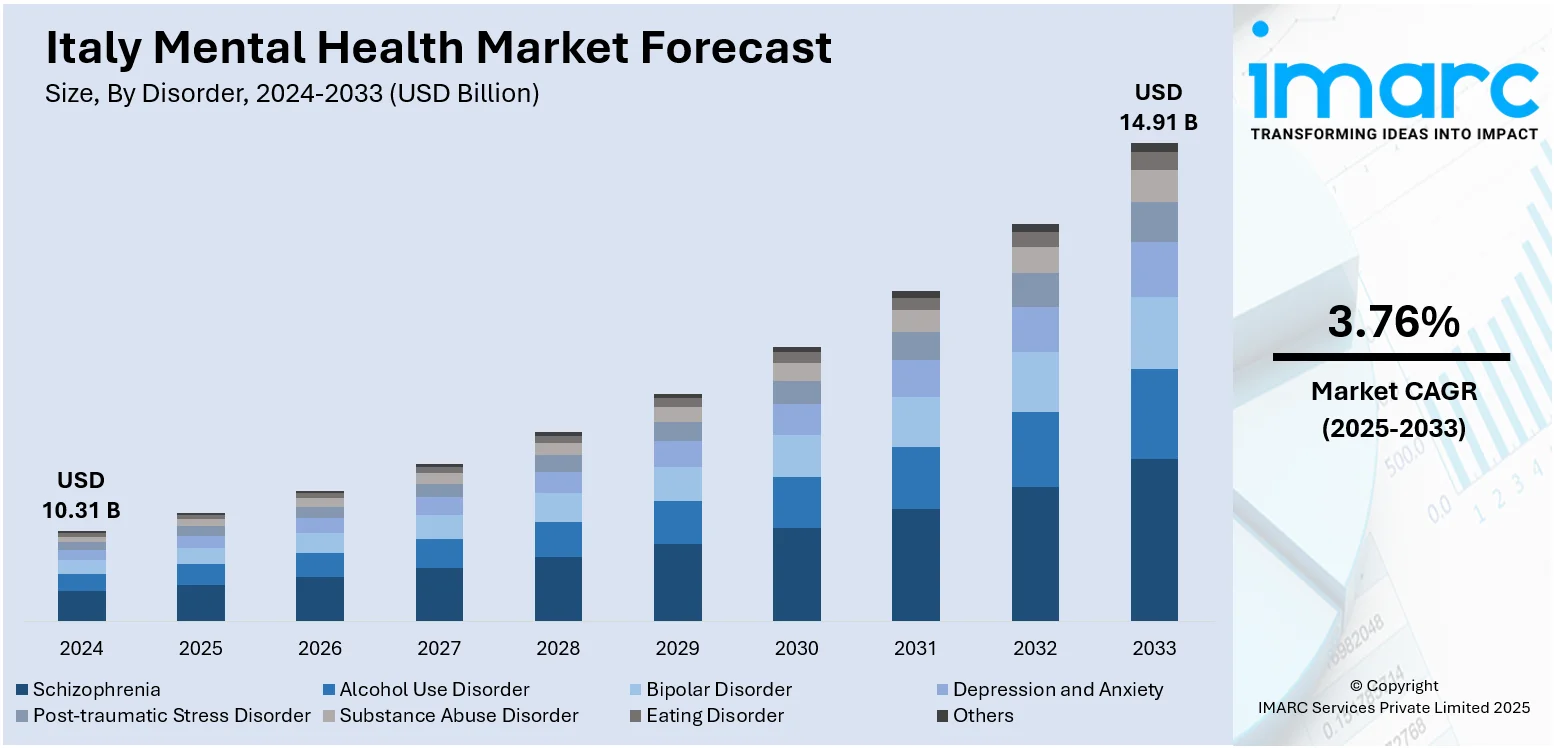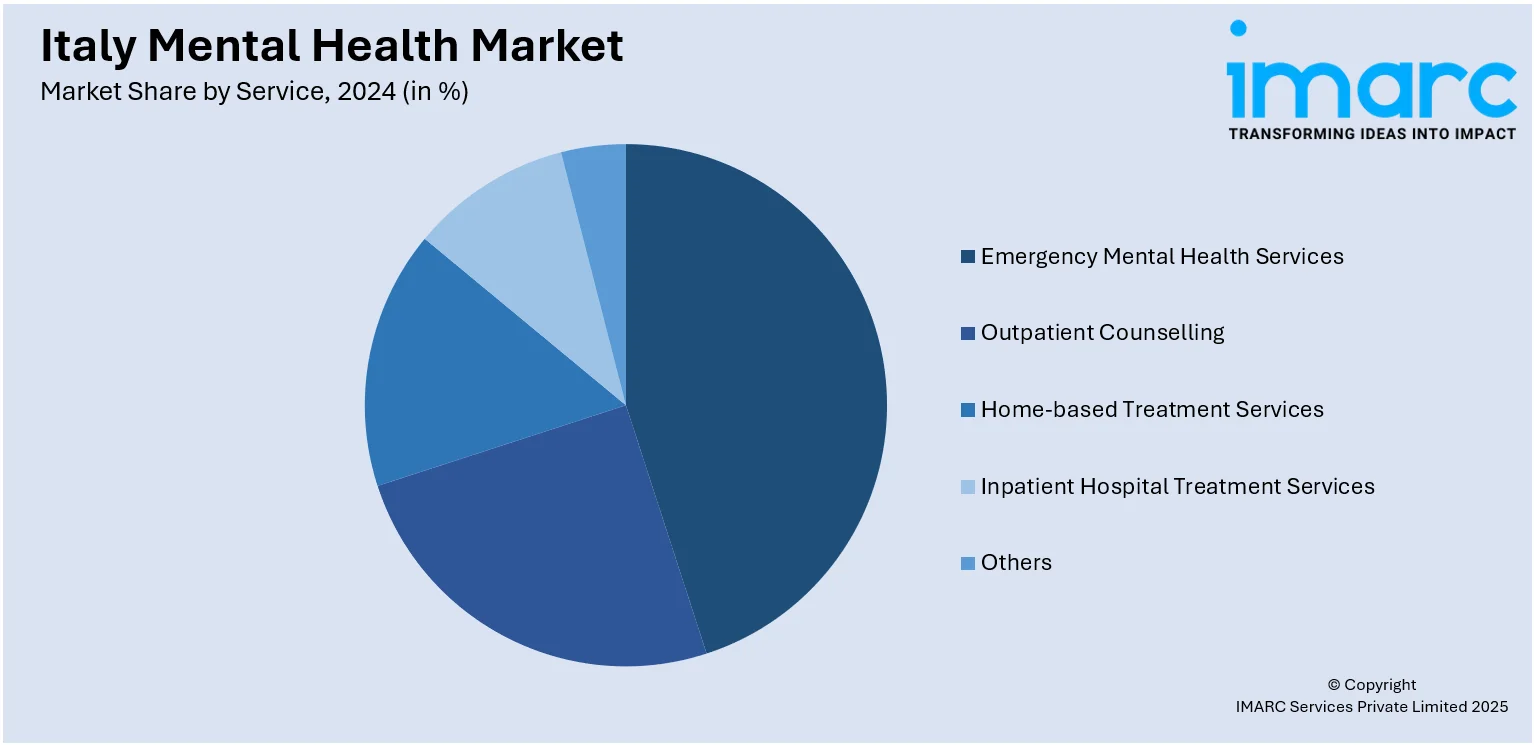
Italy Mental Health Market Size, Share, Trends and Forecast by Disorder, Service, Age Group, and Region, 2025-2033
Italy Mental Health Market Overview:
The Italy mental health market size reached USD 10.31 Billion in 2024. The market is projected to reach USD 14.91 Billion by 2033, exhibiting a growth rate (CAGR) of 3.76% during 2025-2033. The market is propelled by greater awareness regarding mental illnesses, increased acceptance of psychological counseling, and the inclusion of digital tools in care provision. Along with this, government initiatives towards enhancing psychiatric infrastructure, as well as the support for community-based mental health care, are stimulating market growth. Moreover, the increasing incidences of depression and anxiety, particularly in younger population, has fueled the demand for mental health solutions, further augmenting the Italy mental health market share.
|
Report Attribute
|
Key Statistics
|
|---|---|
|
Base Year
|
2024 |
|
Forecast Years
|
2025-2033
|
|
Historical Years
|
2019-2024
|
| Market Size in 2024 | USD 10.31 Billion |
| Market Forecast in 2033 | USD 14.91 Billion |
| Market Growth Rate 2025-2033 | 3.76% |
Italy Mental Health Market Trends:
Digitalization of Mental Health Services
The adoption of digital platforms for mental health services has become a defining trend in the country's healthcare landscape. Telepsychiatry, app-based cognitive behavioral therapy (CBT), and virtual consultations are increasingly common, driven by both necessity and convenience. During the COVID-19 pandemic, regulatory relaxations enabled the rapid scaling of remote mental health care. For instance, a survey conducted in Italy between October 2022 and July 2023 assessed the use and perception of telepsychology among 128 mental health professionals and 113 patients. Most participants had used telepsychology during the COVID-19 pandemic, with video consultations being the preferred method. High satisfaction levels were linked to strong communication, complete information, patient-centered care, and professional-patient rapport. That momentum continues, supported by investments in digital health infrastructure and the inclusion of telepsychology services under national and regional health programs. In addition to this, mobile apps offering mindfulness, stress management, and mood tracking are gaining traction, particularly among younger adults. These tools often complement traditional therapy, enabling better adherence and self-monitoring. Digital mental health startups in Italy are also expanding, with venture capital interest gradually increasing. Artificial intelligence (AI) integration in diagnostics and patient triage is also emerging. Barriers remain, including data privacy concerns, limited digital literacy among older adults, and uneven internet access in rural regions. However, government-backed digitization initiatives are addressing infrastructure gaps and encouraging broader adoption across the population, which is further supporting the Italy mental health market growth.

To get more information on this market, Request Sample
Rising Youth Mental Health Challenges
Mental health conditions among Italy's youth are drawing increasing concern from public health institutions, schools, and families. Incidence rates of anxiety, depression, eating disorders, and self-harm behaviors have risen over the past decade, with a marked uptick post-2020. For instance, industry data from 2024 shows that 60% of Italians reported experiencing mood swings in the past year, with 38% indicating they had suffered from panic attacks. The 18 to 24 age group showed the highest vulnerability, with 72.7% reporting mood fluctuations, 71% experiencing symptoms of depression, and 51.2% dealing with panic attacks. Approximately 29.7% of the population has turned to a psychologist for support, and 10.3% have participated in therapy sessions delivered through online platforms. Apart from this, National surveys and pediatric associations consistently report growing mental distress in adolescents, particularly among girls aged 14–19. The education sector is responding with school-based psychological counseling, peer support programs, and partnerships with local health units (ASL). Meanwhile, pediatricians are undergoing additional training to identify early warning signs and collaborate with child psychiatrists. However, access to specialist care remains uneven. Southern regions face notable shortages of adolescent mental health professionals while waitlists in urban areas continue to grow. In response, policy frameworks are gradually expanding funding for youth mental health initiatives. Pilot programs in cities like Milan and Bologna are testing early intervention models that combine educational outreach with mobile mental health units and digital engagement platforms.
Italy Mental Health Market Segmentation:
IMARC Group provides an analysis of the key trends in each segment of the market, along with forecasts at the country and regional levels for 2025-2033. Our report has categorized the market based on disorder, service, and age group.
Disorder Insights:
- Schizophrenia
- Alcohol Use Disorder
- Bipolar Disorder
- Depression and Anxiety
- Post-traumatic Stress Disorder
- Substance Abuse Disorder
- Eating Disorder
- Others
The report has provided a detailed breakup and analysis of the market based on the disorder. This includes schizophrenia, alcohol use disorder, bipolar disorder, depression and anxiety, post-traumatic stress disorder, substance abuse disorder, eating disorder, and others.
Service Insights:

- Emergency Mental Health Services
- Outpatient Counselling
- Home-based Treatment Services
- Inpatient Hospital Treatment Services
- Others
A detailed breakup and analysis of the market based on the service have also been provided in the report. This includes emergency mental health services, outpatient counselling, home-based treatment services, inpatient hospital treatment services, and others.
Age Group Insights:
- Pediatric
- Adult
- Geriatric
The report has provided a detailed breakup and analysis of the market based on the age group. This includes pediatric, adult, and geriatric.
Regional Insights:
- Northwest
- Northeast
- Central
- South
- Others
The report has also provided a comprehensive analysis of all the major regional markets, which include Northwest, Northeast, Central, South, and others.
Competitive Landscape:
The market research report has also provided a comprehensive analysis of the competitive landscape. Competitive analysis such as market structure, key player positioning, top winning strategies, competitive dashboard, and company evaluation quadrant has been covered in the report. Also, detailed profiles of all major companies have been provided.
Italy Mental Health Market Report Coverage:
| Report Features | Details |
|---|---|
| Base Year of the Analysis | 2024 |
| Historical Period | 2019-2024 |
| Forecast Period | 2025-2033 |
| Units | Billion USD |
| Scope of the Report |
Exploration of Historical Trends and Market Outlook, Industry Catalysts and Challenges, Segment-Wise Historical and Future Market Assessment:
|
| Disorders Covered | Schizophrenia, Alcohol Use Disorder, Bipolar Disorder, Depression and Anxiety, Post-traumatic Stress Disorder, Substance Abuse Disorder, Eating Disorder, Others |
| Services Covered | Emergency Mental Health Services, Outpatient Counselling, Home-based Treatment Services, Inpatient Hospital Treatment Services, Others |
| Age Groups Covered | Pediatric, Adult, Geriatric |
| Regions Covered | Northwest, Northeast, Central, South, Others |
| Customization Scope | 10% Free Customization |
| Post-Sale Analyst Support | 10-12 Weeks |
| Delivery Format | PDF and Excel through Email (We can also provide the editable version of the report in PPT/Word format on special request) |
Key Questions Answered in This Report:
- How has the Italy mental health market performed so far and how will it perform in the coming years?
- What is the breakup of the Italy mental health market on the basis of disorder?
- What is the breakup of the Italy mental health market on the basis of service?
- What is the breakup of the Italy mental health market on the basis of age group?
- What is the breakup of the Italy mental health market on the basis of region?
- What are the various stages in the value chain of the Italy mental health market?
- What are the key driving factors and challenges in the Italy mental health market?
- What is the structure of the Italy mental health market and who are the key players?
- What is the degree of competition in the Italy mental health market?
Key Benefits for Stakeholders:
- IMARC’s industry report offers a comprehensive quantitative analysis of various market segments, historical and current market trends, market forecasts, and dynamics of the Italy mental health market from 2019-2033.
- The research report provides the latest information on the market drivers, challenges, and opportunities in the Italy mental health market.
- Porter's five forces analysis assist stakeholders in assessing the impact of new entrants, competitive rivalry, supplier power, buyer power, and the threat of substitution. It helps stakeholders to analyze the level of competition within the Italy mental health industry and its attractiveness.
- Competitive landscape allows stakeholders to understand their competitive environment and provides an insight into the current positions of key players in the market.
Need more help?
- Speak to our experienced analysts for insights on the current market scenarios.
- Include additional segments and countries to customize the report as per your requirement.
- Gain an unparalleled competitive advantage in your domain by understanding how to utilize the report and positively impacting your operations and revenue.
- For further assistance, please connect with our analysts.
 Request Customization
Request Customization
 Speak to an Analyst
Speak to an Analyst
 Request Brochure
Request Brochure
 Inquire Before Buying
Inquire Before Buying




.webp)




.webp)












